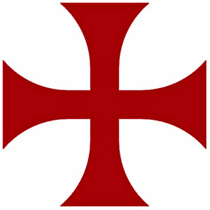...Best of Sicily presents... Best of Sicily Magazine. ... Dedicated to Sicilian art, culture, history, people, places and all things Sicilian. |
by Vincenzo Salerno | ||
Magazine Index Best of Sicily Arts & Culture Fashion Food & Wine History & Society About Us Travel Faqs Contact Map of Sicily |
The order was founded in Palestine around 1107 by Hugh de Payens, a French crusading knight, to protect pilgrims in the Holy Land. A great number of these pilgrims had begun to arrive following the First Crusade a few years earlier in 1099. King Baldwin II of Jerusalem gave them some land on the Temple Mount, from which they took their name. Initially the knights took vows of poverty. Like the Hospitallers, they often participated in battles against the Muslims, most famously against Saladin at Montgisard in 1177. Not only did the Templars establish a number of castles and commanderies in the Middle East, they soon had a number of such communities across Europe - from which they recruited esquires - and in Sicily. The wealth of the Templars, like that of the Hospitallers (Order of Saint John), rivalled that of many sovereigns, a fact that generated a certain degree of envy. This was not the case of the Kingdom of Sicily, then Europe's richest realm, which included most of Italy south of Rome and (at times) territories in Tunisia and the Balkans. As an aid to pilgrims and other travellers, the Templar network of preceptories and commanderies facilitated the novel means of letters of credit to transfer money. Essentially, a sealed document (a "cheque") issued by one commandery could be exchanged for actual funds (gold and silver coins) by another. Checking, as it came to be known and used in modern times, was developed by the Templars, though paper currency was already in use in China. Such instruments obviated the need for wealthier travellers to carry large amounts of coinage which could very easily be robbed by armed bandits. Two of the larger Templar foundations in Sicily were Saint Nicholas of the Temple (San Nicolò del Tempio) in Bulgherano near Scordia (in Catania province) before 1151 and the Saint Mary Carmine Church (Chiesa del Carmine) in Piazza Armerina. There were other commanderies at Caltagirone, Trapani, Siracusa, Butera and Lentini. The most important, at Messina, served as a major stopover for crusaders and Pilgrims en route to the Holy Land by sea. The commanderies at Marsala and Trapani also served the order in this regard, but Messina's was its major administrative centre in Sicily. The Hohenstaufens, as Holy Roman Emperors, were no more kindly disposed toward the Templars than other monarchs, and much preferred the Teutonic Knights, who for the most part were drawn from the German-speaking regions of Europe and sometimes lent military support to Imperial campaigns in Europe. By 1200, the Teutonic Order had important commanderies based in Sicily in Palermo (the Magione) and Messina (Saint Mary of the Germans). The Hohenstaufens had inherited the Templars and Hospitallers of Sicily from their Hauteville predecessors. There was no immediate effort to remove either order. Frederick II was not only King of Sicily and Holy Roman Emperor (and King of the Germans) but, by right of his second wife, Isabella (Yolande) of Brienne, King of Jerusalem. He arrived in Palestine leading the "Sixth Crusade" in 1229. Ostensibly, this was a military campaign to rein in the Muslims. In fact, Frederick, who spoke Arabic, reached an agreement with them while having himself crowned. For this reason and others, the Templars did not support Frederick in the Holy Land. The king did not forget their treason. Upon his return to Sicily, he confiscated all their properties on the island and assigned these to the rival Hospitallers. A few of these estates were still in the possession of the Hospitallers when they were expelled from Malta in 1798. The Templars were allowed to retain most of their estates in peninsular Italy. The order's removal from Sicily presaged their deposition in France during the next century. The Templars are gone but, given their colorful history, hardly forgotten. About the Author: Palermo native Vincenzo Salerno has written biographies of several famous Sicilians, including Frederick II and Giuseppe di Lampedusa. | |
Top of Page |
 Much legend and supposition
surrounds the history of the Knights Templar, and even certain documents
recently discovered in the Vatican archives about the end of the Order of
the Temple in 1307 shed little new light on the established facts. The Templars'
Sicilian presence came to an end long before the order disappeared across
the rest of Europe.
Much legend and supposition
surrounds the history of the Knights Templar, and even certain documents
recently discovered in the Vatican archives about the end of the Order of
the Temple in 1307 shed little new light on the established facts. The Templars'
Sicilian presence came to an end long before the order disappeared across
the rest of Europe.